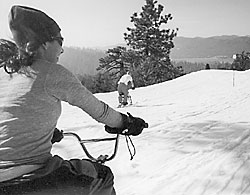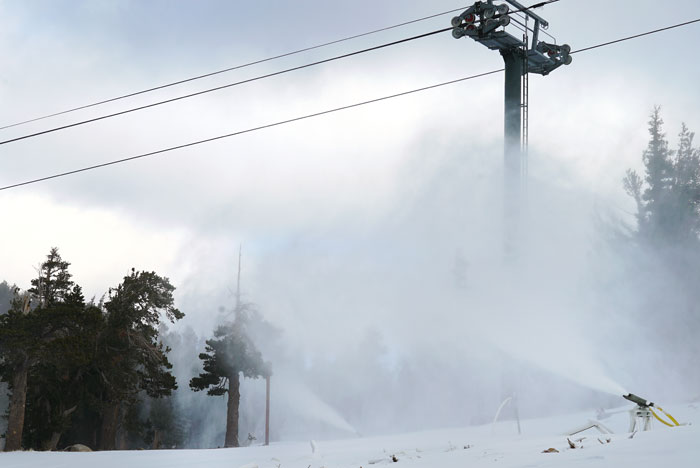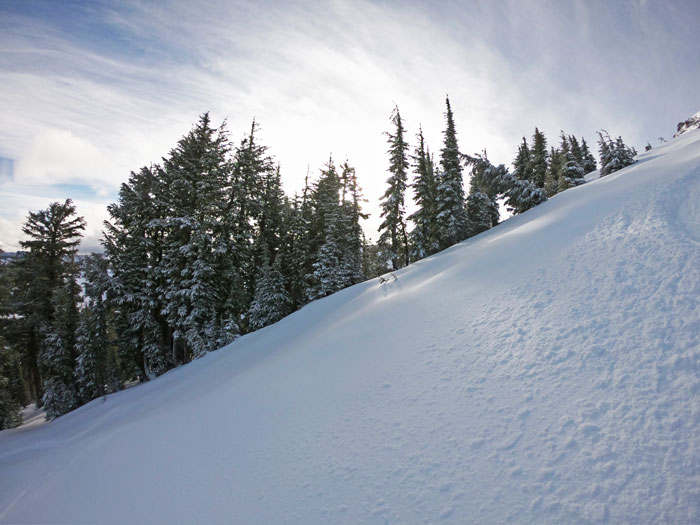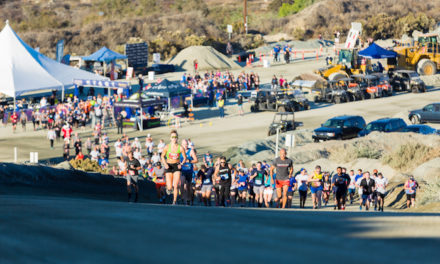- Tahoe’s Nevada Beach Tops the List of Hard-to-Book Campgrounds - 07/17/2024
- Cannabis Watershed Protection Program Cleans Up Illegal Grow Sites - 07/10/2024
- French Fire - 07/05/2024
Story by Samantha Staley • Photos by Matt Hanson
 “Are you sure this is for me?” I ask Matt Hanson, founder and C.E.O. of Winter-X-Bike, as he unlocks a Turner DH Racer from his van’s roof rack. “Can you ride a bike?” he asks me without breaking his focus. “Well, yeah… ” Hanson hops off the van, pulls the bike down and hands it to me. “Then you can ride a ski-bike. Let’s go.”
“Are you sure this is for me?” I ask Matt Hanson, founder and C.E.O. of Winter-X-Bike, as he unlocks a Turner DH Racer from his van’s roof rack. “Can you ride a bike?” he asks me without breaking his focus. “Well, yeah… ” Hanson hops off the van, pulls the bike down and hands it to me. “Then you can ride a ski-bike. Let’s go.”
I’m at Sierra-at-Tahoe ski resort in beautiful South Lake Tahoe learning to ski-bike for the first time. Matt is my teacher. He is passing through Tahoe to promote his Ski-MX kit that converts any bike into a ski-bike by exchanging the wheels and cranks for modified skis.
I’m feeling a little apprehensive. I’m 30 years old, can’t snowboard for the life of me, and although I grew up on skis, it’s been five years since I’ve taken them out of the attic.
I scramble to keep up with Hanson as he heads toward the mountain. “Wait… how do I get on the lift? How do I stop? How do I slow down? I don’t know if I should be doing this… ” Despite my protests, Hanson continues marching across the parking lot to the lifts.
We get in line. The lift loops around and scoops up some of the beginner boarders ahead of us. “Okay,” says Hanson, patting my bike seat. “Hop on and do exactly as I do.” I hop on the converted Turner, plant my feet, and wait for our turn. As soon as the next seat clears our path to collect the pair in front of us, we push off and glide our bikes to the red line.
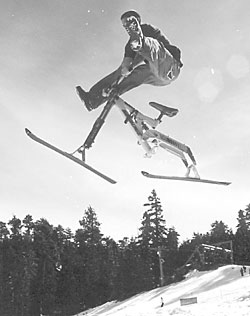
I’m about to get on the lift to the bunny hill and I’m petrified. I haven’t felt this way since I was six years old and first learning to ski. Hanson explains the lift procedure to me. This basically goes in one ear and out the other, so when the seat comes around I just copy everything Hanson does. He brings the lift bar down and shows me how to hook my bike seat over the bar and then secure it with the safety strap. I’m no longer terrified. I’m a kid again, riding the lift for the first time.
But my next test is fast approaching… disembarking with this foreign contraption.
“They’re not going to slow the lift down for you,” says Hanson, practically reading my mind. Step by step, he breaks down the exit procedure. “Easier said than done!” I snap at him. The unloading ramp is two chairs ahead of us and Hanson already has his safety strap unlatched and is helping me with mine. Just in time, it’s undone and we lift up our bike seats and raise the bar. I angle the front of my bike up just like Matt’s and as soon as the ramp approaches our feet, the Turner engages with the snow and glides in front of me. I stand up and run ungracefully down the ramp with the bike, stopping when I think I’m safely out of the way. Hanson, meanwhile, jumps right onto his seat and rides off with both feet on the foot pegs.
Although he taught skiing and snowboarding for five years, Hanson says he hasn’t quite figured out the best way to teach ski-biking. “You can tell someone how to get on and off the lift, but they’re not going to get it until they actually do it. And as for the getting down the mountain, it’s just like riding a bike.”
There are some fundamental differences, however, that warrant mention. Chief among them: On a ski-bike you don’t have brakes, other than skidding your ski edges. And using your handlebars alone to turn without the proper body english is even less effective than on two wheels. Hanson says a half-hour lesson should be mandatory for any novice.
Thirty minutes. Is he kidding? I tried snowboarding for two full days and still can’t stand up. But Hanson has more faith in my abilities.
“Okay, try to follow in my tracks,” he says, pointing his Specialized Enduro down the hill. He pushes off, then brings both feet up on the pegs. He glides part way down the hill and then effortlessly carves to the left with a gentle lean. I try to follow his graceful line but end up dragging by boots on the snow all the way.
Hanson laughs. “That’s a good start. You can certainly keep your feet down as much as you want. You can even use your feet to stop, but the proper way is by carving the skis.”
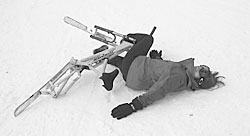
With surging confidence, I race down past him and try to pull a stop. I stop all right. Face down in the snow. All part of the learning experience, though. By the time we reach the bottom of the bunny hill, I am gliding and pivoting and stopping with little trouble. Now it’s time for “Sugar ’n’ Spice,” a more challenging run.
Up the lift we go, to about 9,000 feet. The woman next to us is full of questions.
“So it works with any bike?” she asks.
“Any bike,” says Hanson. “Whether you’ve got a BMX, a road bike, an old frame you’ve got lying around in the garage from 20 years ago…doesn’t matter.”
“Beach cruiser?” she asks.
“Even a beach cruiser.”
“What about a tandem bicycle?” I ask, trying to be a smart ass.
“That’s next season,” Hanson says. “We even have a cross-country version.”
Early Beginnings
Like a fevered scientist, Hanson has been trying to cross pollinate bikes and skis for most of his life. At age 12, in the basement of his parent’s home in Rockville, Maryland, he carved out his first ski-bike conversion kit from a couple blocks of wood. “I loved biking and I loved skiing. I just needed to find a way to marry these two sports.”
He had a few bike frames laying around and some broken skis that he could never part with and the revelation struck him: Why not screw them together? Although his first results were expectedly crude, his concept was validated.
Twenty years later, after a great deal of refinement and an aeronautical science degree from Embry-Riddle University, Hanson’s ski-bike conversion kit has graduated from wood to aero-space grade aluminum, and from rigid screws to axles and torsion springs.
Three years ago, Hanson finally got the resources together to turn his boyhood tinkering into a business. After acquiring a patent, he launched Winter-X-Bike and hit the road, from trade shows to resorts, to promote the sport of freestyle ski-biking. “It starts with demand,” he says. “Nobody’s going to buy the Ski-MX kit if they don’t know about the sport or if resorts don’t allow it on their mountains.”
The number of ski-bike friendly resorts in the U.S. and Canada has grown from around 20 to more than 50 in the last three years.
Is this what it was like for Jake Burton, I wonder, 25 years ago, when hardly anyone had heard of snowboarding? “I didn’t invent foot-ski-less ski-biking,” Hanson clarifies. “If anyone should be credited, it should be Don Koski, who’s been designing ski-bikes with foot pegs for the past 30 years. I only came up with a way to make it more affordable and user-friendly because you can use the bike you already own.”
With his Ski-MX conversion kit, Hanson has helped to foster the sport by making it much more accessible. Whereas quality dedicated ski bikes can cost $1,000 to $1,500, for as little as $130 you can turn the bike you already have into a ripping winter toy. When the snow’s gone, just put the wheels back on and hang up the skis for next year.
Hanson spends the winter touring resort towns in his head-turning Winter-X-Bike van with all the bikes on the roof, spreading his hedonistic gospel to as many people as possible. He has produced an extreme ski-biking DVD that currently plays at several resorts. His invention has been the subject of TV features and magazine articles in such publications as Outside, the Los Angeles Times, and even Fortune Magazine.
“It’s a slow process, but you will see… this sport is going to take off,” he assures me.
Maybe by that time, I’ll be able to show off a tail-whip and a superman seat-grab… or at least learn to get off the lift gracefully.
Here’s a list of ski bikes that are available in the U.S.
The K2
Retails for $800. A dedicated ski-bike with a cushy seat that requires foot skis (included with purchase). Can be purchased from most K2 retailers or rented at some resorts. The K2 snowcycle is only available as a rental at
some ski resorts and is not available for purchase by the public.
- Pros: Available for rental at ski-bike friendly resorts.
- Cons: Restricted to winter use and a bit squirrelly without the foot skis.
The Koski Bike
Retails for $1500. A well-engineered, dedicated ski-bike with a large, comfortable seat, and a steep price. Can be purchased online from Koski Snowsports atwww.daydreamsunlimited.com/koski/
- Pros: Made to withstand the most daring stunts and did I mention the comfortable seat?
- Cons: Expensive.
The Ski-MX Kit from Winter-X-Bike
Retails for $129.95 without skis and $299.95 with skis. Can be purchased online from WinterXBike.com or from several Tahoe shops: Sports LTD, 123Bikes, Tahoe Bike and Ski, and Sierra Ski & Cycle Works.
- Pros: Allows year-round use, works on most bikes, affordable.
- Cons: If you can find a con, let me know.
Visit www.usasba.orgfor information on other manufacturers and the sport in general.

